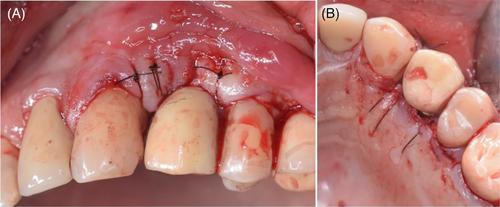Surgical reconstruction of peri-implantitis with adjunctive antimicrobial photodynamic therapy: A case report with 5-year follow-up
Abstract
Background
Peri-implantitis poses a significant challenge in dental implantology due to its potential to result in the loss of supporting tissue around dental implants. Surgical reconstruction is often recommended for intrabony defects, accompanied by various adjunctive therapies, such as antimicrobial photodynamic therapy (aPDT), for bacterial decontamination. However, the long-term efficacy of such treatments remains unclear.
Methods
This clinical report presents a case of peri-implantitis management in a healthy 55-year-old male using guided bone regeneration principles and surface decontamination via aPDT. The patient exhibited peri-implantitis with probing pocket depths (PPD) of 7 mm at buccal sites, 5 mm at palatal sites, and significant bone loss around implant #12. The reconstructive approach involved preservation of the existing implant and following a non-submerged healing protocol. The surgical phase included meticulous debridement, chemical detoxification with hydrogen peroxide, and aPDT using a 670 nm diode laser with methylene blue as the photosensitizer. Xenogenic bone graft and a resorbable collagen membrane were applied and the patient was followed up to through a 5-year period.
Results
Postsurgery the patient exhibited normal healing, and long-term follow-up at 5 years showed reduced PPD (2 mm buccally, 3 mm mid-palatally), complete intrabony defect fill, and stable bone levels, indicating successful treatment.
Conclusions
This case report demonstrates the potential long-term success of a reconstructive approach with adjunctive aPDT in peri-implantitis management. However, it highlights the need for standardized protocols and further clinical trials to establish the clinical benefits of aPDT in surgical reconstruction of peri-implantitis defects, serving as valuable pilot data for future research.
Key points
- Provides a rare 5-year insight into peri-implantitis intrabony defect reconstruction, offering extended success and outcomes not frequently documented.
- Demonstrates the efficacy of aPDT with a 670-nm diode laser in achieving successful long-term outcomes, contributing valuable evidence to existing literature.
- Success involves initial non-surgical debridement followed by a reconstructive strategy, incorporating guided bone regeneration and surface decontamination via aPDT.
- Long-term success hinges on patient compliance with routine oral hygiene, emphasizing the importance of adherence to preventive measures post-reconstruction to minimize recurrence risk.
- Variability in photosensitizer uptake, and potential risks such as tissue damage and bacterial resistance pose challenges to the effectiveness of aPDT.
- The existing literature on aPDT in peri-implantitis treatment lacks standardization in methodology, laser parameters, and follow-up durations, making it challenging to establish a universally accepted protocol.


 求助内容:
求助内容: 应助结果提醒方式:
应助结果提醒方式:


